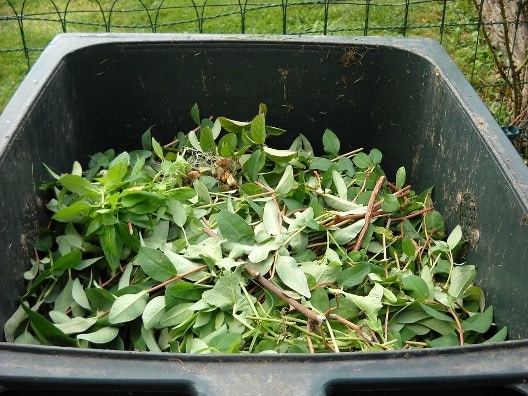Green waste is a type of biodegradable waste that you can find in your garden and backyard. Between 2018-2019, Australian households contributed to 70% of our total green waste, with a large portion ending up in landfill.
Luckily, green waste can be helpful to the environment when properly recycled. However, if you mismanage your green waste, it can end up in landfill, which is highly toxic.

Common Green Waste in Australia
Green waste is an umbrella term that you can apply to any of the following materials:
- Garden waste
- Food waste
- Organic waste
- Grass clippings
- Lawn clippings
- Shrub or hedge cuttings
- Woodchips
- Bark
- Weeds
- Tree branches
- Tree stumps
Why Garden Waste is Harmful to the Environment
Incorrect disposal of your green waste is likely to head to a landfill. Green waste takes up valuable space that we could use for non-recyclable rubbish. In addition, when green waste is decomposing in landfill, it releases high amounts of toxic methane gas, which is harmful to our environment.
In 2018, 1345 kilotons of our green waste went to landfill which could have been recycled.
Green waste in landfill can also be a fire hazard during the summer, seriously harming the environment. Furthermore, a collection of green waste can create a breeding ground for rats, snakes and weeds.
Stormwater can also carry mismanaged green waste into our creeks, rivers and beaches. When combined with water, plants soak up the limited amounts of available oxygen and release excessive nutrients. As a result, it leaves our marine life with no oxygen, and the oversupply of nutrients create toxic algal blooms.
Why Is Green Waste Recycling Important?
Australia produced over 4 million tonnes of green waste in 2018, with close to 30% of it ending up in landfill. Recycling green waste not only benefits the environment but can also benefit you as well.
Here are some reasons why recycling green waste is important.
Reduce Space in Landfill
There’s only so much space for non-recyclable rubbish in a landfill, so why would we fill it up with materials like trees and plants? Also, green waste in landfills can produce methane, a gas that is toxic to our environment.
Creates High Quality Compost
Green waste recycling can make great compost that’s rich in nutrients. The compost is better than synthetic fertilisers as it helps plants grow deeper roots and reduces the need to use chemical poisons like pesticides.
Reuse Waste and Save Money
The Government has made initiatives across Australia like the NSW Food Smart program, which can educate you about reusing leftover food scraps. As a result, you can save money on your weekly grocery shop.
Get in contact with your local council to find out if they offer any community recycling services for green waste. If they don’t, you can easily create your own composting system at home.
Also, to ensure that certain types of green waste avoids the landfill, be sure to dispose it correctly by putting it into the appropriate bin.
What Can Be Put In Green Waste Bins?
In every Australian household, you should be able to find your wheelie bin with a green lid. This bin is only for certain types of green waste.
To avoid mixing waste products during the recycling process, it’s important that you dispose of your green waste in the correct bin.
For example, you wouldn’t want to open a bag of fresh compost only to find bits of plastic through it. This is a result of incorrect green waste disposal, mixing plastic with their green materials.
Here’s what you can put in your green waste bin:
- Garden and grass clippings
- Tree and shrub prunings
- Fresh or dry leaves
- Flowers
- Twigs and branches (under 30 cm in size)
- Leaves
- Certain types of weeds (ask your local council for the kinds of weeds that you can put in your green bin)
Here’s what you can’t put in your green waste bin:
- Food scraps
- Woodchips
- Soil
- Gravel and rocks
- Building materials
- Tree stumps and large branches (thicker than 10cm)
- Plant pots and garden materials
- Paper and cardboard
- Green waste wrapped in plastic bags
- Biodegradable packaging
Don’t worry! You can still recycle or reuse the green waste that would normally end up in your general waste bin.
How to Recycle and Reuse Green Waste
Luckily organic waste is 100% recyclable, so there’s plenty of options that you can use to manage your green materials effectively and help our environment.
The key to recycling green waste is organisation. It’s a good idea to have a system that works best for you when recycling or reusing your green waste. If you live in a house or an apartment with other people, sit down with them to organise the best-suited recycling strategy.
Here are some methods on how to recycle and reuse your green waste.
Composting for Fertiliser
Composting is a great and easy way to recycle your green waste. If you don’t want to compost in your own home, try to contact your local council to ask if they have a shared compost system with other community members.
Thermal Treatment
With effective green waste recycling, facilities can turn the organic material into biogas or biofuel. Thermal treatment involves heating your waste to turn it into an environmentally friendly energy source that powers our planet.
Contact Specialised Services
You can always contact a professional waste service to help you manage your green waste recycling.
Whether you’re on a construction site or just working on your garden, our experienced team at 1300RUBBISH can help you keep your green waste out of skip bins and landfills. We offer a wide range of services including removal, bin collection and recycling.
If you would like more information on our green waste service, you can call us at 1800 229 046 or fill in an online form.

